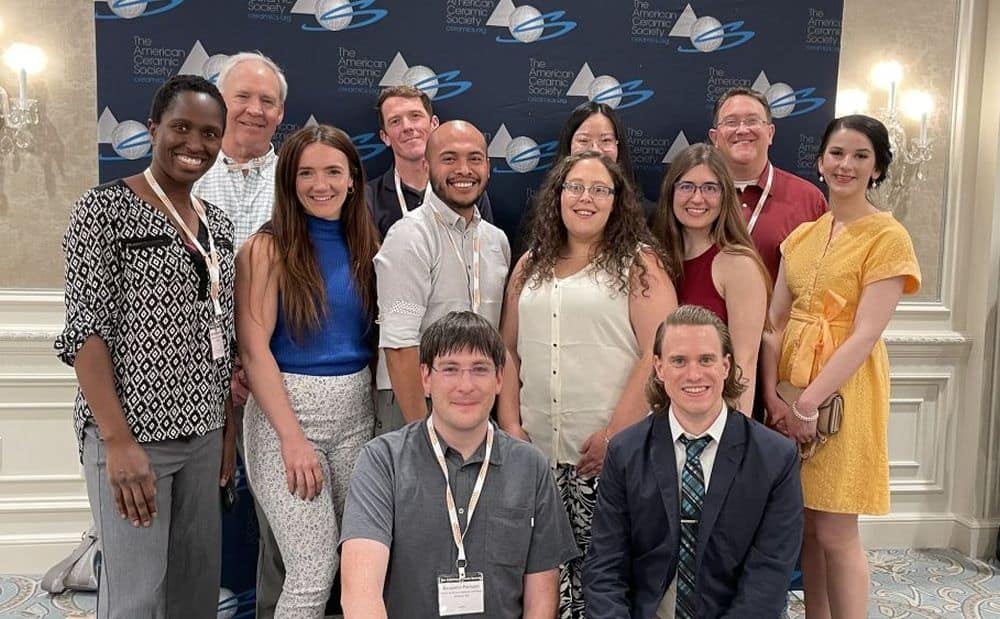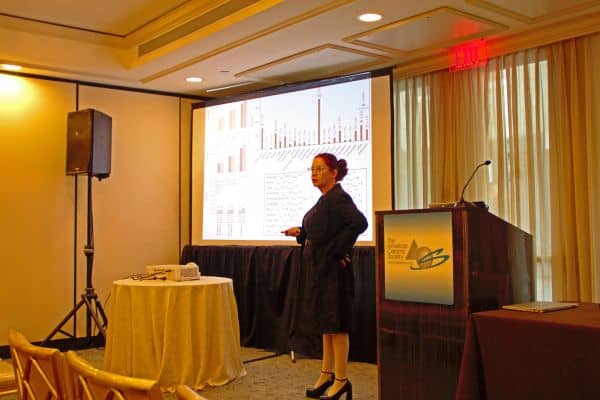
[Image above] Proof that glass people are happy people. Credit: ACerS
The historic Hotel Monteleone in the French Quarter of New Orleans provided the setting for this year’s Glass & Optical Materials Division Annual Meeting on June 4–8, 2023.
Organized by Walter Kob (University of Montpellier) and Qiang Fu (Corning Inc.), the conference welcomed just over 300 people—including 73 students—from 21 countries. About 40% of the attendees were from outside the United States, with the largest representations coming from France, India, Japan, and the United Kingdom.

The tone was set for an engaging conference at Sunday evening’s welcome reception with a New Orleans-styled photo booth, complete with Mardi Gras costumes, headdresses, and feathery wings. You will not want to miss those pictures!
On Monday, the conference was planned to open with the Stookey Award lecture. Sadly, this year’s recipient, Nicholas Borrelli, passed away in late January before he could accept the award. Instead, Borrelli’s colleague, Matt Dejneka, accepted the award posthumously on his behalf and presented a tribute to Borrelli’s prodigious, prolific career at the conference banquet.
On Tuesday, Stéphane Gin, senior scientist at the French Atomic Energies and Alternatives Energy Commission, presented the Morey Award lecture titled “Even glass corrodes in contact with water.” Gin got interested in glass corrosion while in graduate school, noting that “glass is everywhere, and water is everywhere.” Using thermodynamics and kinetics, his ultimate goal is to develop a predictive model for long-term corrosion, on the order of 1 million years.
Gin’s work shows that there is not a universal corrosion mechanism in play but rather several mechanisms. Thus, the predictive model will need to be multifaceted to accommodate a spectrum of mechanisms across various parameter regimes. He says, “The question of my life has not been solved, but we have made progress!”
Qi Zhou from the University of California, Los Angeles, presented her Ph.D. work at the Norbert J. Kreidl Award lecture. Her work focuses on understanding how basic structural features in silica glass control properties, similar to how DNA controls characteristics of living organisms. See her extended abstract in the June/July 2023 ACerS Bulletin.

Lisa Klein (Rutgers University) and Manoj Choudhary (Ohio State University and Owens-Corning [retired]) presented the Darshana and Arun Varshneya Frontiers of Glass Science/Technology Award lectures, respectively.
Klein, ever the consummate educator, used ice cream and chocolate chip cookies to describe complex principles of gel glass structure and glass transition behavior.
Choudhary’s talk focused on industrial-scale glass melting technologies for reducing carbon footprint. The glass industry has been proactive in this area, for example, with electric boosting and all-electric melting, but challenges remain. He cited a February 2023 DOE report estimating that the U.S. need 47,300 gigawatt-miles of new power lines to meet growing demand, much of it coming from energy-intensive industries.
Two L. David Pye Lifetime Achievement Awards were presented at the banquet to Steve Feller of Coe College and (in absentia) to Carlo Pantano, retired from The Pennsylvania State University. Students were recognized for outstanding poster presentations.

In addition to the usual symposia and program tracks, GOMD chairs added a new session on STEM outreach, organized by Charmayne Lonergan (PNNL) and Katie Goetschius (Corning Inc.). As employers are well-aware, the industry faces a persistent dearth of talent. This session looked at several programs designed to communicate the rewards of STEM careers to young students and to help them see how impactful careers in glass can be.
A few programs featured at the conference included, among others, the Ceramic and Glass Industry Foundation’s outreach activities; Olivia Graeve’s ENLACE summer program, which links about 180 Mexican and U.S. high school and graduate students; and the Pacific Northwest National Laboratory’s STEM Ambassador program.
The glass and optics community always strives to do as much as they can while together, so there was also a poster session, publishing workshop, career panel discussion, glass corrosion short course, and ASTM meetings. And a whole lot of interesting conversations!

Be sure to come to GOMD 2024, which will take place next May 19–24 in Las Vegas. Images from GOMD 2023 are available on the ACerS Flickr site. See who braved the feathery photo booth!
